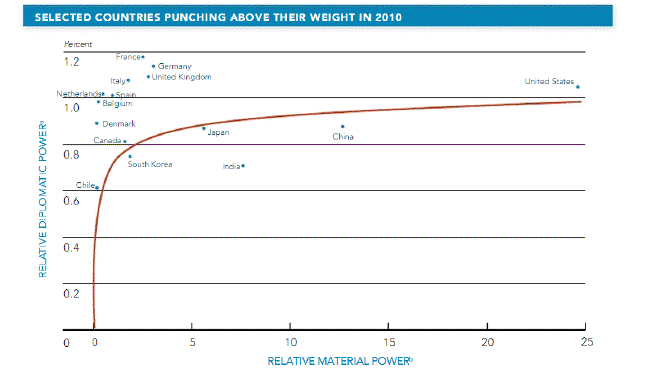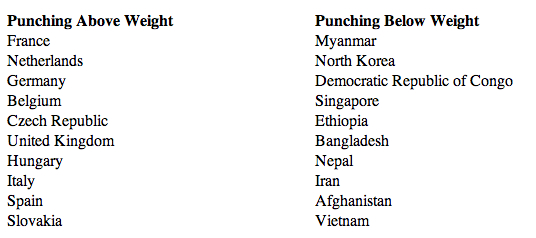Though tricky to define and even more challenging to measure, there's no denying that power is a fundamental driver of country behavior in the international political system. Policy decisions and political maneuvers are often shaped by how a nation views its own power in relation to other nations. Yet, as the U.S. National Intelligence Council's newly released Global Trends 2030 report indicates, these dynamics are constantly shifting. What we might have considered "powerful" decades ago may be irrelevant today.
The Frederick S. Pardee Center for International Futures teamed up with National Intelligence Council's authors to help track these changes in power more quantitatively. Together we used the International Futures (IFs) modeling system -- which employs a database of more than 2,500 historical sources to analyze relationships among nearly a dozen different country subsystems -- to deliver much of the geopolitical forecasts found in the Global Trends 2030 report.
Our hope is that President Obama and those in U.S. intelligence and policy circles look to the year 2030 and beyond with a more nuanced view of these changing global dynamics.
Traditional measures of material power -- typically understood as the kind of power that can be directed towards violence -- have shifted across time. For instance, back in the mid-20th century, the amount of iron and steel that your country produced was an important driver of world power. Today, however, the fact that the United States doesn't produce as much steel as it did in the 1970s is not an indication of her weakness.
Largely due to forces related to globalization, the components that are relevant for measuring material power in today's geo-political space will only continue to shift. The IFs model used two different measures of material power to capture this changing dynamic, as presented in Global Trends 2030. Each of these helps us to understand how to view power more effectively, both in the past and the future.
Components and weights of the first power measure were originally created by the Strategic Assessments Group in Washington, D.C. This measure reflects global material power distribution related to the post-Cold War context, capturing GDP, military spending, population size and technology. Here, the United States has about 25 percent of the world's power for the majority of the period following the end of the Cold War. By the same measure, Chinese power has grown from seven percent at the end of the Cold War to about 12 percent today. According to this gauge, the power of China and the U.S. should meet around 2030, as shown here.
An alternative measure of national capabilities considered variables that contribute to material power in an increasingly globalized world. The Emerging Issues and Advanced Analytics Group in Washington, D.C., originally created weights for this second index. In this measure -- referred to as the Global Power Index, or GPI -- the variables include factors such as Information Communication Technology, R&D spending and government revenue creation. Likewise, though in the past the overall size of a given nation's population would be most telling, the model's alternative measurement considers the size of that population relative to each country's levels of education and health. Additional measures -- like foreign direct investment, humanitarian aid and energy imports -- also capture some of the increasing importance of the current structure of the global system. The forecast of this second power variable is more favorable to the United States by 2030, though the long-term trend remains unchanged (the East still rises, the West still declines).
The bar-graph below breaks down the distribution of material capabilities based on IFs forecasts and can be found in the Global Trends 2030 report on page 101.

Though clearly important, material power is not the only determinate of state behavior in the international system. Diplomatic power -- that is, the power of a country's multilateral and bilateral agreements and institutional ties -- also plays an important role. Using IFs, we calculated the relative share of diplomatic power for each country and compared the relationship between material power and diplomatic power. For certain countries, the two diverge quite drastically.
As the graph below shows, countries that are above the line can be considered to be punching "above" their weight in the international system. In other words, they exert more diplomatic influence on global politics than we would expect based on their levels of material power.


The table below ranks the countries that punch most above and below their weight based on the cross-sectional plot above.

As you can see, the countries that most punch above their weight are entirely European, bolstered by centuries of formal diplomacy. Countries that punch below their weight tend to be either international pariahs, or those whose material power greatly outstrips their diplomatic bandwidth, such as Singapore. Looking forward, U.S. policymakers can use such analyses to judge the trajectory of the country's own relative resources and capabilities and inform strategic decisions about alliances, etc.
There's a certain inevitability regarding the rise of countries like China, especially economically and in military capability. However, the United States and its partners should not view this as inevitable obsolescence. By focusing on measures of power that are augmented by forces of globalization -- those reflected in the Global Power Index, for example -- along with continued emphasis of institutional and diplomatic structures, the United States and European nations can remain vital to the functioning of an international society long into the future.